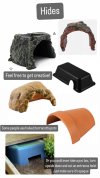Littleredfootbigredheart
Well-Known Member
Hello there!
In this thread I’m going to include some information an example of an appropriate indoor set up for an older Herman/russian.
As much as it’s encouraged to have tortoises in a safe outdoor enclosure, I understand being from the uk myself, that some climates make it difficult to house outdoors full time, an outdoor enclosure is great for them to enjoy where possible though! I would generally discourage free roaming outside of a safe enclosure.
Care advice for these guys is painfully behind, fb pages, YouTube, pet stores, they’re all repeating the same outdated advice, this forum is made of people who have spent years finding the best ways to care for them that actually result in healthy tortoise, I’ve taken the knowledge of these lovely folks and applied it into making this thread.
I know it looks a lot to go over, I like to make sure all bases are covered, I’m happy to break down any information as and where needed, just ask!
I’m going to cover the types of equipment to use, how to maintain humidity, and a cost effective way for you to get a suitable sized enclosure, hopefully it helps inspire some ideas🙂
Some of the equipment examples will vary from location to location with brands etc, however with the indoor UV, the examples shown are generally the only two brands you’ll want to go for. Cheaper alternatives are unreliable and sometimes dangerous. I’m from the uk so some of my examples reflect that.
As adults they need a minimum of an 8x4 enclosure, roaming is vital to tortoise health, it aids digestion and strengthens their muscles.
Size wise you’ll still have so many people recommending far too small a set up for adults, Don’t think they can get away with smaller if allowed to free roam, I’d highly discourage indoor free roams, being away from their heat source means they’re being exposed to temperatures that are too low quite often, smooth surfaces like laminate flooring will wreak absolute havoc on their hip joints over time.
There’s just numerous reasons it isn’t a good idea, harmful floor cleaners, foreign objects being swallowed, getting stuck under things they shouldn’t like shelving or sofas, low temperatures, no uv, getting hit by doors, one member has mentioned they knew someone who’s tort got their head crushed in a door jam😣, flipping hazards, smooth services, the list goes on and is endless.
They feel most comfortable and safe in a space that best mimics their natural environment, our homes don’t.
They don’t have reasoning skills to understand why they are uncomfortable somewhere, they just want to explore, which is why an appropriate size is so important, it helps build their muscle strength and aids in digestion. They’d walk miles in the wild!
Even outdoor free roaming isn’t a good idea for safety, they should always be somewhere secure.
Basking light should be an incandescent floodlight(examples attached) on a 12 hour timer.
Basking temperature directly under the floodlight should be 95-100f. The rest of the enclosure should be ranging 75-80 during the day.
You may also wish to add ambient lighting on the same timer, providing shady areas with hides and safe plants.
Then CHE/CHE’s(ceramic heat emitters) always on a thermostat, for night heat if your house drops below 60’s at night. Set the thermostat for a night temperature place the probe in their cooler end, plug the che into it and the thermostat into the mains, it’ll be plugged in 24/7 but will only turn on when the temperature drops. If in a cooler climate you might need these, if not, do temp checks at night to see if they’re necessary.
Any indoor Uv should be a t5 fluorescent tube, avoid the compact and coil uv bulbs, they don’t give out enough uv and can hurt the tortoises eyes. The uv can be on a 4 hour timer from noon. I’ve attached examples of the two brands to go for and some examples of how to mount them. The Arcadia proT5 kit 12% comes with the reflector fitting, the reptisun needs it buying separate.
With lighting always avoid anything labelled halogen or mercury vapour.
For substrates, either coco coir, dampened and packed down by hand as a base, with a layer of orchid bark or forest floor on top, or just the orchid bark/forest floor. Never use anything with sand mixed in, no top soils and no kinds of moss. The problem with top soil is unless you’ve composted it yourself, you don’t know what kind of plants have gone into it, it could be something toxic. Sand can irritate the eyes and be an impaction risk, moss is an impaction risk too.
You want to aim to have the bottom layer of substrate damp, to do this pour lukewarm water into the corners, not loads but enough to dampen the entire bottom layer. To stop that top layer getting too dry/dusty, mix the substrate now n then. Check your monitors and substrate to do the pours as and when needed.
I’d personally recommend you make your own base to go as big as you possibly can for the space you have. The closer you can get to an 8x4 size the better.
When making your base, just make sure the material is safe, some use flower beds, or take a large bookcase, take out the shelves and lie flat, or just make their own, for all these options I’d line with cheap pond liner to protect the base, making sure the liner goes up the sides too and make sure those sides are deep enough! They can be professional escape artists😂
I’ve also included examples of stands people make/buy to hang their lighting, use a temperature gun to determine how high the basking bulb needs to be, the Arcadia uv needs to be mounted 18-20 inches from the top of the tortoise’s shell.
For a water dish a shallow terracotta saucer is considered safest, they have grip in the event your tortoise flips themselves, most pet store options are a known hazard.
Ignore whatever else is in these enclosures in the photos, they’re just to give you an idea, some are a smaller example too but hopefully they inspire!👍
They also benefit from 2-3 half hour soaks a week💦
I’d also always recommend getting your hands on a temp gun, they’re SO handy when setting up a new environment or for checking your monitors are correct🙂
Have digital monitors that measure both temp and humidity, the gauge ones are inaccurate.
For the diet side of things, avoid fruits, You want to stick with leafy greens and weeds for these guys, perhaps some of you will find this link below useful, maybe you could get some seeds offline and plant into organic soil(no fertilisers or chemicals) in a planter the tortoise doesn’t have access to, forage them as they grow😊be very wary foraging elsewhere, you can’t be sure there’s no chemicals and they’re toxic lookalikes so always double check.

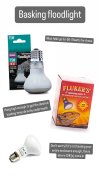
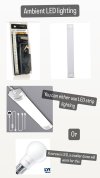
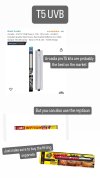




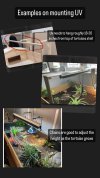
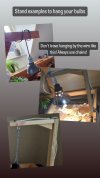

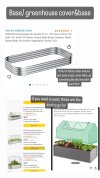
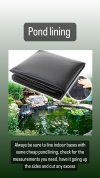

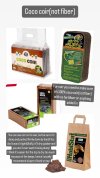
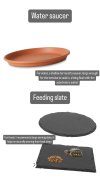



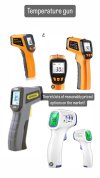

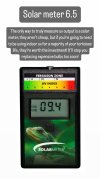
In this thread I’m going to include some information an example of an appropriate indoor set up for an older Herman/russian.
As much as it’s encouraged to have tortoises in a safe outdoor enclosure, I understand being from the uk myself, that some climates make it difficult to house outdoors full time, an outdoor enclosure is great for them to enjoy where possible though! I would generally discourage free roaming outside of a safe enclosure.
Care advice for these guys is painfully behind, fb pages, YouTube, pet stores, they’re all repeating the same outdated advice, this forum is made of people who have spent years finding the best ways to care for them that actually result in healthy tortoise, I’ve taken the knowledge of these lovely folks and applied it into making this thread.
I know it looks a lot to go over, I like to make sure all bases are covered, I’m happy to break down any information as and where needed, just ask!
I’m going to cover the types of equipment to use, how to maintain humidity, and a cost effective way for you to get a suitable sized enclosure, hopefully it helps inspire some ideas🙂
Some of the equipment examples will vary from location to location with brands etc, however with the indoor UV, the examples shown are generally the only two brands you’ll want to go for. Cheaper alternatives are unreliable and sometimes dangerous. I’m from the uk so some of my examples reflect that.
As adults they need a minimum of an 8x4 enclosure, roaming is vital to tortoise health, it aids digestion and strengthens their muscles.
Size wise you’ll still have so many people recommending far too small a set up for adults, Don’t think they can get away with smaller if allowed to free roam, I’d highly discourage indoor free roams, being away from their heat source means they’re being exposed to temperatures that are too low quite often, smooth surfaces like laminate flooring will wreak absolute havoc on their hip joints over time.
There’s just numerous reasons it isn’t a good idea, harmful floor cleaners, foreign objects being swallowed, getting stuck under things they shouldn’t like shelving or sofas, low temperatures, no uv, getting hit by doors, one member has mentioned they knew someone who’s tort got their head crushed in a door jam😣, flipping hazards, smooth services, the list goes on and is endless.
They feel most comfortable and safe in a space that best mimics their natural environment, our homes don’t.
They don’t have reasoning skills to understand why they are uncomfortable somewhere, they just want to explore, which is why an appropriate size is so important, it helps build their muscle strength and aids in digestion. They’d walk miles in the wild!
Even outdoor free roaming isn’t a good idea for safety, they should always be somewhere secure.
Basking light should be an incandescent floodlight(examples attached) on a 12 hour timer.
Basking temperature directly under the floodlight should be 95-100f. The rest of the enclosure should be ranging 75-80 during the day.
You may also wish to add ambient lighting on the same timer, providing shady areas with hides and safe plants.
Then CHE/CHE’s(ceramic heat emitters) always on a thermostat, for night heat if your house drops below 60’s at night. Set the thermostat for a night temperature place the probe in their cooler end, plug the che into it and the thermostat into the mains, it’ll be plugged in 24/7 but will only turn on when the temperature drops. If in a cooler climate you might need these, if not, do temp checks at night to see if they’re necessary.
Any indoor Uv should be a t5 fluorescent tube, avoid the compact and coil uv bulbs, they don’t give out enough uv and can hurt the tortoises eyes. The uv can be on a 4 hour timer from noon. I’ve attached examples of the two brands to go for and some examples of how to mount them. The Arcadia proT5 kit 12% comes with the reflector fitting, the reptisun needs it buying separate.
With lighting always avoid anything labelled halogen or mercury vapour.
For substrates, either coco coir, dampened and packed down by hand as a base, with a layer of orchid bark or forest floor on top, or just the orchid bark/forest floor. Never use anything with sand mixed in, no top soils and no kinds of moss. The problem with top soil is unless you’ve composted it yourself, you don’t know what kind of plants have gone into it, it could be something toxic. Sand can irritate the eyes and be an impaction risk, moss is an impaction risk too.
You want to aim to have the bottom layer of substrate damp, to do this pour lukewarm water into the corners, not loads but enough to dampen the entire bottom layer. To stop that top layer getting too dry/dusty, mix the substrate now n then. Check your monitors and substrate to do the pours as and when needed.
I’d personally recommend you make your own base to go as big as you possibly can for the space you have. The closer you can get to an 8x4 size the better.
When making your base, just make sure the material is safe, some use flower beds, or take a large bookcase, take out the shelves and lie flat, or just make their own, for all these options I’d line with cheap pond liner to protect the base, making sure the liner goes up the sides too and make sure those sides are deep enough! They can be professional escape artists😂
I’ve also included examples of stands people make/buy to hang their lighting, use a temperature gun to determine how high the basking bulb needs to be, the Arcadia uv needs to be mounted 18-20 inches from the top of the tortoise’s shell.
For a water dish a shallow terracotta saucer is considered safest, they have grip in the event your tortoise flips themselves, most pet store options are a known hazard.
Ignore whatever else is in these enclosures in the photos, they’re just to give you an idea, some are a smaller example too but hopefully they inspire!👍
They also benefit from 2-3 half hour soaks a week💦
I’d also always recommend getting your hands on a temp gun, they’re SO handy when setting up a new environment or for checking your monitors are correct🙂
Have digital monitors that measure both temp and humidity, the gauge ones are inaccurate.
For the diet side of things, avoid fruits, You want to stick with leafy greens and weeds for these guys, perhaps some of you will find this link below useful, maybe you could get some seeds offline and plant into organic soil(no fertilisers or chemicals) in a planter the tortoise doesn’t have access to, forage them as they grow😊be very wary foraging elsewhere, you can’t be sure there’s no chemicals and they’re toxic lookalikes so always double check.
The Tortoise Table - Home
The Tortoise Table plant database and resource site for Tortoise owners
www.thetortoisetable.org.uk






















